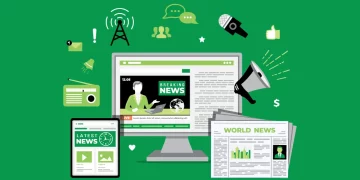In the age of information overload, where content consumption is at an all-time high, one question stands out: Are articles more persuasive than visual content? This question hinges not just on the form of content but on its ability to sway, influence, and captivate an audience. Both articles and visuals play critical roles in communication, but each approaches persuasion from different angles. To answer this, we need to dissect both types of content, understand how they influence human cognition, and evaluate their effectiveness in various contexts.
The Power of Words: Articles as Persuasive Tools
Cognitive Engagement through Language
Articles, at their core, leverage language to build a connection with the reader. Unlike visuals, which present immediate emotional responses, articles require deeper cognitive engagement. The reader needs to process the language, analyze the structure of arguments, and integrate information to form opinions. The depth of this process often leads to stronger retention of the information.
Research has shown that people tend to remember written content better because it demands more active involvement from the reader. This cognitive effort makes it easier for an article to build trust with the audience. A well-written article can persuade by presenting a detailed argument, providing evidence, and appealing to logic and reason. The very act of reading allows individuals to critically assess and analyze content, which increases the likelihood of changing their perspectives.
Articles and Storytelling: Connecting Emotionally Through Words

Although articles are primarily informational, they also have a unique ability to connect with readers on an emotional level through storytelling. When crafted with compelling narratives, articles can evoke empathy, create suspense, and trigger emotional responses. This is particularly true when the writing is focused on personal experiences, case studies, or persuasive essays that offer both facts and emotional appeal.
In contrast to visuals that provide instant emotional reactions, articles often take time to build that connection. Readers might begin with skepticism but, through a gradual development of the narrative, may eventually be convinced. Think of articles as long-term persuasion tools. Their power lies in their ability to unfold information systematically and give readers time to reflect on what they read.
Expertise and Credibility
One of the main advantages of articles is their ability to convey expertise. When a writer presents well-researched information with supporting evidence, articles build credibility. Readers tend to trust content that cites sources, presents logical arguments, and delivers detailed analysis.
For example, academic papers, professional blogs, and long-form investigative journalism all carry weight because they are perceived as authoritative. The persuasive power of these articles lies in their ability to provide in-depth knowledge and a nuanced understanding of the topic, often addressing multiple sides of an argument. This makes them more suitable for persuading an audience that requires more than surface-level information.
The Impact of Visuals: Immediate, Emotional, and Powerful
The Visual Advantage: Instantaneous Impact
Visual content—whether it’s an image, infographic, video, or graphic design—has an immediate and powerful impact on the viewer. Unlike articles, which demand time and attention to digest, visuals provide instant emotional engagement. Colors, shapes, composition, and motion can evoke immediate feelings of joy, fear, excitement, or sadness. For this reason, visuals are often used in advertising, social media campaigns, and public service announcements to drive quick emotional responses.
For instance, a powerful image of a natural disaster aftermath may stir feelings of empathy and urgency, compelling viewers to donate to a relief fund without reading a single word. In this sense, visuals are incredibly effective at persuading audiences quickly and without much effort on the part of the viewer. This instant emotional connection can be far more persuasive in certain contexts, particularly when the goal is to elicit an immediate response.
Visual Content and the Cognitive Load
Though visuals are quicker to digest, they require less cognitive effort compared to reading an article. This can be both an advantage and a limitation. While visuals are more accessible and can be processed in a fraction of the time, they may not always provide enough depth for a persuasive argument. A visual can grab attention and spark interest, but to truly persuade, it often requires the support of written or spoken content.
Moreover, visuals often rely on symbolism and metaphors, which can leave room for interpretation. This ambiguity can either be a strength or a weakness, depending on the context. For example, a politically charged image may communicate a message without words, but its meaning might be more polarizing than an article that explains the topic with nuance.
Social Media and Visual Persuasion
In the digital age, visuals have become central to the persuasive power of social media platforms. Infographics, memes, short-form videos, and visual advertisements dominate these spaces. Studies have shown that content accompanied by images performs better on social media in terms of engagement, shares, and overall influence. Platforms like Instagram, TikTok, and Pinterest have transformed the way persuasion works by leveraging the power of images and videos to create immediate, viral content.
These platforms depend on visuals because they are easy to consume, share, and resonate with diverse audiences across the globe. However, while visual content is fantastic for drawing attention and sparking initial interest, it may not be enough to sustain engagement or persuade on more complex issues. This is why many social media campaigns follow up their visual appeal with articles, blogs, or videos that provide deeper context.
Comparing the Persuasive Power of Articles vs. Visuals
The Role of Context in Persuasion

The effectiveness of articles and visuals in persuasion depends heavily on the context in which they are used. For issues requiring detailed analysis, logical reasoning, and careful consideration, articles often take the lead. Topics such as politics, economics, healthcare, and education benefit from articles because they provide the space to explore multiple facets of an issue and appeal to an audience’s intellect.
In contrast, when the goal is to influence quickly or emotionally, visuals tend to outperform articles. Advertising, branding, public awareness campaigns, and viral marketing all rely on the immediate power of visuals to influence public perception.
Furthermore, the combination of both forms—articles and visuals—can be incredibly persuasive. A visual can capture attention, while an article can provide the depth and argument necessary for persuasion. In this sense, the two forms work in synergy, playing to each other’s strengths.
Emotion vs. Logic
At the heart of persuasive content lies the interplay between emotion and logic. Visuals are inherently emotional; they capitalize on our ability to quickly process and react to images. Articles, on the other hand, often appeal to logic and reason, requiring readers to engage more deeply and reflect on the message.
However, this doesn’t mean that visuals can’t incorporate logic or that articles are devoid of emotion. For example, an infographic may combine both visual appeal and data to persuade, while an article may include personal stories to evoke empathy. Both forms can leverage emotional and logical appeals, but the balance of each differs.
Conclusion: Which is More Persuasive?
The question of whether articles are more persuasive than visual content doesn’t have a one-size-fits-all answer. It all depends on the situation, the medium, and the audience. Articles are more effective when the goal is to provide in-depth analysis, foster critical thinking, and build long-term trust. They are indispensable for issues that require detailed explanations and evidence-based arguments.
On the other hand, visuals are invaluable for making a quick emotional impact, grabbing attention, and prompting immediate action. Their effectiveness in social media, advertising, and branding demonstrates how well visuals work in capturing interest and persuading on a shallow level.
Ultimately, combining both—leveraging the power of words and visuals—can create a more holistic, effective persuasive strategy. The key to success lies in understanding the strengths of each medium and applying them appropriately depending on the context.



















































